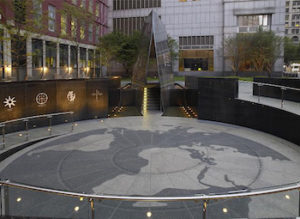
On this date in 2003, an African Burial Ground in New York City was re-established and re-consecrated.
The African Burial Ground is a 6-acre cemetery used between the late 1600s and 1796 and contained between 10,000 and 20,000 burials. The discovery of the African Burial Ground occurred in June 1991. Earlier that month, construction workers began to dig the foundation for a new $300 million federal government building in lower Manhattan. It all stopped when they came upon the burial ground, where they found wooden coffins and human remains.
Investigators discovered that this colonial burial ground was used to bury Black African slaves who were not buried in church cemeteries, even if they had converted to Christianity. These enslaved African people had been treated harshly in colonial America. The 415 remains, which were finally recovered from the site more than 200 years later, were buried with great care and love by the Black colonial community. They were wrapped in linen shrouds and positioned in well-built cedar or pine coffins, sometimes with beads or other treasured objects, occasionally with ornamentation on the coffin.
The African Burial Ground reminds us of the contribution of African people, both slave and free, to the building of New York City. Many people were not aware that New York was a slave state in the early days of the nation. During the 18th century, New York had the largest enslaved population in North America except for Charleston. It is estimated that Africans comprised 14-20 percent of New Yorkers during those days.
The two-day observance of the Rites of Ancestral Return commemorative observance began with a Departure Ceremony at Howard University. They were then celebrated as contributors of African Americans as their ancestral remains from the African Burial Ground were returned from Washington, D.C., to New York City.
Dr. Kofi Asare Opoku, a religious scholar from Ghana, poured water from a small gold bowl onto the ground and prayed in his native tongue. The remains were given a permanent resting place at the African Burial Ground Memorial Site.
A portion of the African Burial Ground was established as a National Monument by Presidential Proclamation on February 27, 2006.